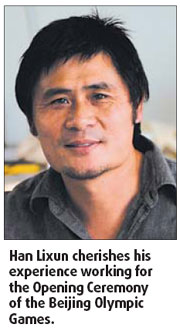 Performers practice inside the movable type pieces. Xinhua
Performers practice inside the movable type pieces. Xinhua
For Han Lixun, chief creative director of set design for the Beijing Olympics Opening Ceremony, the process was one of continually dreaming up, improving upon and sometimes abandoning creative ideas.
"We had come up with so many ideas and schemes that there was enough material to fill 10 opening ceremonies," he says.
One of Han's earliest ideas made the final cut and became a highlight of the opening ceremony - the type matrix.
During the performance, 897 movable type pieces formed different arrays and presented three styles of the Chinese character "he" ("harmony" or "peace"), displaying to the world a traditional Chinese concept that dates back to the time of Confucius.
"We wanted to show Chinese civilization in the opening ceremony, but there is so much in 5,000 years of Chinese history. What and how should we show it to the world?" says Han. "We decided to use the movable types because movable type printing is one of the greatest inventions of ancient China, and it can be presented vividly through acting."
However, bringing this idea to the stage wasn't easy. General director Zhang Yimou requested that the performers inside the movable type raise the pieces to 4 meters high within one second, and with one hand.
This seemed almost a mission impossible to Han at first. As he explained, the pieces were quite heavy, and the performers had to raise and lower them many times during a performance. After a failed experiment, 50 versions had to be scrapped and the creative team was forced to change its direction.

Han did not want to give up, though. He kept trying. One day he was suddenly inspired by the mechanism of scissors and the Chinese steelyard, which enables one to raise heavy things with little strength. The revised movable type weighs 18 kilograms, but the performers needed only a force of 3 kilograms to raise the pieces.
"I don't like to rely on high technology in set design, for high technology also means high risk," he says. "I hope to achieve a good design through wisdom."
Chinese culture is an endless source of inspiration for Han's creations. This is why he chose to come back to China after three years of study at the Staatliche Kunstakademie Dusseldorf in Germany from 1991-93.
"I want to work in my own culture, so that I can have the greatest freedom in creation," he says.
Han had another idea for the Opening Ceremony - an opera stage that opens up like a folded New Year card. As actors perform Chinese operas on this paper-cut-like stage, the audience in the front would see a Chinese opera show, while the audience in the back would see a shadow play on a screen between them and the actors.
Unfortunately, Zhang eventually gave up the idea, fearing that such a stage would distract the audience from the opera itself.
"It doesn't matter. I believe I will have an opportunity to realize the idea in the future," says Han, who is now preparing to take part in the design of the opening ceremony of the 16th Asian Games and the Expo 2010.
He is also writing a book about his experience working for the Opening Ceremony of the Beijing Olympic Games, a two-year process during which he practically had no holiday.
"I want to make an account of this process. It is a fortune, not only for me, but also for the whole society," he says.
Born in 1962 in East China's Zhejiang province, Han had been a teacher at Shanghai Academy of Drama and a set designer at the Oriental Song and Dance Ensemble. His past works included the opening ceremony of the fourth World Women's Congress, and the opening ceremony of the 21st Summer Universiade.
(China Daily 08/19/2008 page15)